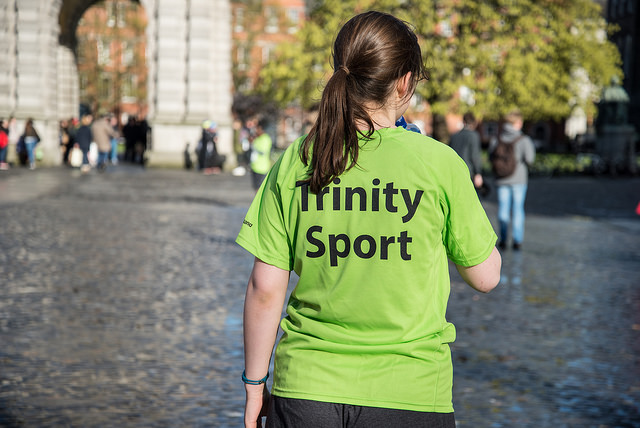Sometimes it is hard to see past the physicality of rugby. The game may appear to be about strength, with its hard hits and crunching tackles, but there is so much thought involved. To be a rugby player, you need to be alert and aware, qualities that Ailis Egan, Nora Stapleton, Jenny Murphy and Sophie Spence have in abundance.
The women’s game has enjoyed momentous growth over the past few years, and whether the players acknowledge it or not, they are at the forefront of that growth, shaping the image of the sport and asserting its presence in the public consciousness. This is no accident. Sitting down with them, I was struck by how their every answer demonstrated how much thought they put into the game: each step is planned out, each goal visualised and each piece of encouragement appreciated.
This thinking began in the early days for these players. Coming to rugby much later than their male counterparts, starting in their late teens and early twenties, everything needed to be learnt quickly. As a result of this late start, previous sporting experience is often thought of as key. However, the players soon draw attention to how different rugby is to any other sport. “You could maybe have a fantastic athlete playing rugby, but you might be able to see that they are new to the actual sport, as for example, their passing isn’t as sharp or crisp”, comments Murphy.
While technical skills can be drilled into players, the biggest difference between other sports and rugby is the change in the way of thinking
While technical skills can be drilled into players, the biggest difference between other sports and rugby is the change in the way of thinking. Egan brings up the issue of space awareness on the pitch, using these players past sports as a comparison. “Netball and gaelic football are all about movement and getting into space, and rugby is so different. That’s where the struggle is.” Stapleton goes further, commenting on the on the fact that many female players are still getting used to the game’s tactical side. “Women are so new to the sport that we need to figure it out – when is there a scrum or a lineout, where should we attack, should you kick, should you pass out wide, where do we find the space.”
The need to adapt isn’t just an issue when transitioning from other sports, but even when moving up the levels in Irish rugby. This season, young players who have risen through the school system and and played at college level are breaking through into the provincial and national teams at an unprecedented rate. How much of a difference do they see in these players coming up through the ranks in comparison to players transitioning from other sports? Spence, who is involved with training young rugby players through The Spence Academy, comments that although they have had more basic training, it is the game experience and mentality that they are lacking. All the women agree how big of a step up the international game is in comparison to provincial rugby and even the All-Ireland League, the top women’s league in the country.
We can’t control what happens with the pitch – so we might as well step back and relax and prepare mentally for when we do have to go back out there
Egan comments on how her first match in the green jersey was much faster than she had expected. All four of the players seem to have gotten a shock during their first match, in a more literal sense for Egan who jokes that fellow stalwart Marie Louise Reilly shouted at her to “wake up”. Spence comments on the difficulty of settling yourself in such a fast environment for the first time: “I think I was doing laps across the pitch and then wasn’t hitting any rucks because I was trying to get to everything. And that’s where game awareness comes in. You have to be smart and put yourself in the best position.”
This awareness comes with match experience, and can only be developed in practice, not in theory. However, that is not to say mental preparation is obsolete. For certain players, including Stapleton, preparing mentally has become more important than a physical warm up before a match. She describes how before the Ireland-Scotland match this year she had to pull out of the warm up after five minutes. While trying to work out her injury so she could play, she completed the rest of her preparation mentally in the medical room. Murphy had a similar experience, which led her to understand how big an impact mental preparation can have. “I’d probably say mentally now, but I wouldn’t have said that before this year.” When discussing how she had to pull out of the warm up for the England game in March, she recalls her panic. She was missing a chance to prepare, both individually and as part of the team. It was only when she began to calm down and go over the steps to her game in her head that she really understand the importance of mental preparation.
Mental preparation becomes crucial when a game isn’t going to plan. It becomes more difficult when external factors intrude, like the situation during the Ireland-France match in 2015. Nearly straight after the half-time kick off, the floodlights failed and the Ashbourne pitch was plunged into darkness. As a spectator that day, I couldn’t imagine how difficult it must have been to stay focused. Yet, when I brought it up with the women, all of whom played that night, they tell a different story. The way Egan describes it makes it seem like they had a rave in the changing room, with music playing and players dancing. However, Murphy is quick to comment that although they were relaxing, the feeling was that they were playing well and that they could push on for a win. Stapleton once again brings it back to the mental strength of the team: “You’re always reminded as players you can only control the controllable, and that was one of those things – we can’t turn the lights back on, we can’t control what happens with the pitch – so we might as well step back and relax and prepare mentally for when we do have to go back out there.”
They did a survey of people coming through the gates, and 40 per cent of them were male, and only a tiny percentage were related to the team. That went against everything inside the view and outside of the view of who supports women’s rugby
Spence notes how the influence of senior players is crucial to setting the tone of the team. In moments such as that French match, the ability of the more experienced players to take control of the situation shone through. Now, two years on from that match, these women are some of the most experienced on the team, and are actively taking on the leadership roles that come with that experience. Egan in particular appears to be an important influence in the forward pack, helping to restrain the emotions that hit you on a rugby pitch. “As you get older, you see people’s personalities and how they react in certain situations. I know there are certain times that I have to keep certain people in the pack calm and make sure they don’t go over the edge.”
This leadership is also key to moral within the team. Sometimes even the most experienced players need a confidence boost. Spence recalls a moment of doubt before the Welsh game in 2016, when her warm up did not go to plan and she suddenly doubted her ability to perform come game time: “I freaked out because that is not me”. Spence, who was shortlisted for Women’s World Rugby Player of the Year, credits Egan for giving her the confidence to put in a solid performance, because “all it takes is for someone to bring you back into that scenario.” Ireland won the match 21-3.
Support from the crowd has also been a huge motivator for the team, especially with the new reach the women’s game now has, with their Six Nations matches being televised. However, according to Stapleton, the game has always had a more expansive fan base than presumed: “Everybody thinks the norm was that female rugby was only supported by family, friends and females, while that has been proved completely untrue. They did a survey of people coming through the gates, and 40 per cent of them were male, and only a tiny percentage were related to the team. That went against everything inside the view and outside of the view of who supports women’s rugby.”
Even when we joke about the everyday training sessions, the women balance their thinking between the short term, such as their next step on the pitch, and the more long-term
The fact that fans of the men’s game are coming over in support of the newer women’s sport gives a lift to the team. Spence comments that “it’s quite a shock, because one, they are watching, and two because they are making a positive comment they are paying attention”. The respect that they are getting from their fans, from people of all ages, is being used by the girls to push them forward. The impact younger players have on these women is particularly clear. This can be seen in the response to Stapleton’s story about the French game last February. She got a text from a friend passing on what he had heard in the crowd. Two girls had been commenting about her playing style, with one turning to the other and stating that she wanted to be like Nora Stapleton when she grew up. The impact of such a statement was clear from their faces in reaction to that story, showing how they go out to play for much more than themselves.
It is motivation like this, both from fans and from teammates, that seems to continue to encourage them and help them prepare. Even when we joke about the everyday training sessions, the women balance their thinking between the short term, such as their next step on the pitch, and the more long-term, looking ahead to the Rugby World Cup. Egan tells of a wrestling drill she did with fellow international Lindsay Peat recently. For each stage she called out their future opposition, in an attempt to motivate her teammate: “This is us against Australia. This is us against Japan.”
However, when I ask whether the World Cup has become the main focus, they claim that it’s the run-up that they are looking towards. Their first camp is fast approaching, and with 48 women named in the training squad, these established players still have to earn their spot. Yet, with this amount of experience, mental strength and desire to prove themselves in front of a home crowd, I have little doubt that I will be watching these women stake their claim for the World Cup come August. Certainly, if their mental preparation is anything to go by, they are ready for it.







